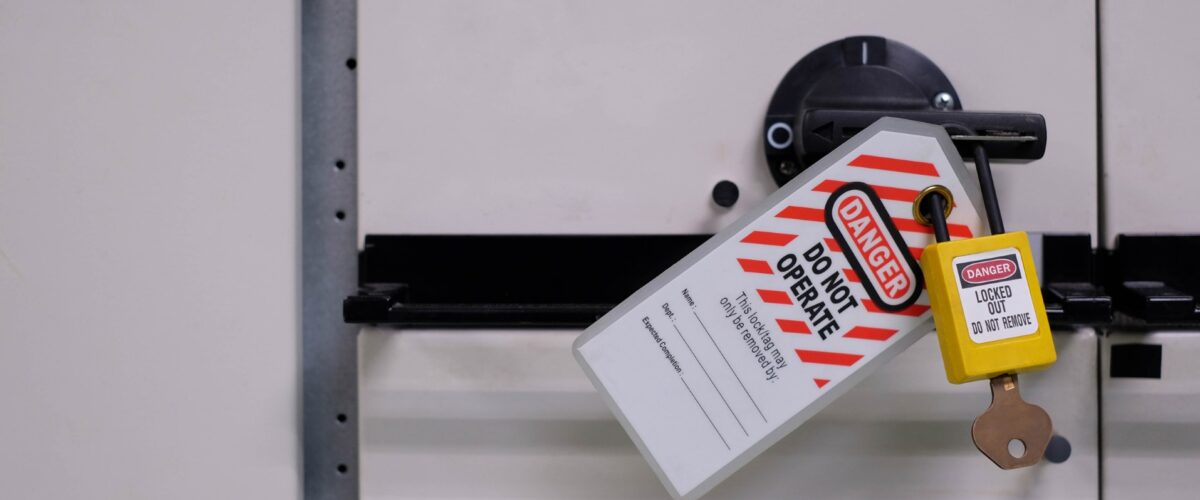- Cal/OSHA (California Occupational Safety & Health Association)
Lockout/Tagout is the disabling of equipment to control the release of potentially hazardous energy while maintenance or service activities are being performed. Energy sources include, but are not limited to: Required initially, before work is performed, whenever there is a change in process, procedure, or hazard and a refresher recommended every 1 – 3 years. The Occupational Safety & Health Association (OSHA) standard for The Control of Hazardous Energy (Lockout/Tagout), Title 29 Code of Federal Regulations (CFR) Part 1910.147, addresses the practices and procedures necessary to disable machinery or equipment, thereby preventing the release of hazardous energy while employees perform servicing and maintenance activities. The standard outlines measures for controlling hazardous energies—electrical, mechanical, hydraulic, pneumatic, chemical, thermal, and other energy sources. The standards establish requirements that employers must follow when employees are exposed to hazardous energy while servicing and maintaining equipment and machinery. Some of the most critical requirements from these standards are outlined below: Occupational Safety & Health Association (OSHA) requires that all facilities that use equipment on which cleaning, repairing, servicing, setting-up and adjusting will be performed must have written hazardous energy control procedures for locking out and tagging out equipment. Lockout and tagout rules affect everyone — even those worker who don’t actually service equipment. OSHA requires lockout and tagout because failure to lockout machinery before working on it is a major cause of serious injury and death in California. The course covers the lockout/tagout program and procedures and how to use locking/tagging devices. What is Lockout/Tagout (LOTO)? Why is Lockout/Tagout (LOTO) training necessary in California? Who needs Lockout/Tagout (LOTO) training? What types of energy sources are covered by Lockout/Tagout (LOTO)? How often should Lockout/Tagout (LOTO) training be conducted in California? What are the key components of a Lockout/Tagout (LOTO) program? What is the purpose of a Lockout/Tagout (LOTO) procedure? What is the role of locks and tags in Lockout/Tagout (LOTO)? Can anyone remove a lock or tag during a Lockout/Tagout (LOTO) procedure? What should I do if I encounter equipment with a lock or tag on it? What are the consequences of not following Lockout/Tagout (LOTO) procedures in California? Are there specific Lockout/Tagout (LOTO) procedures for different types of equipment? Can Lockout/Tagout (LOTO) procedures be temporarily bypassed for convenience or to save time? What is the importance of conducting Lockout/Tagout (LOTO) inspections? Can contractors or temporary workers perform Lockout/Tagout (LOTO) without training? What steps should be taken in an emergency during a Lockout/Tagout (LOTO) procedure? Is Lockout/Tagout (LOTO) training transferable between companies in California? Can Lockout/Tagout (LOTO) procedures be used for equipment with multiple energy sources? How can employees stay updated on Lockout/Tagout (LOTO) procedures and regulations? Who is responsible for overseeing Lockout/Tagout (LOTO) compliance in California-based companies? Where can I find qualified Lockout/Tagout (LOTO) trainers? Contact Us, request a Lockout/Tagout (LOTO) training. Let us ensure your personnel complete the required training so your team is fully prepared to implement your Lockout/Tagout (LOTO) program. Lockout / Tagout (LOTO) Training
Regulatory bodies
Who needs it
Regulation reference
What our training provides:
The session is approximately 1 hour in length.
Request a Free EHS Compliance Assessment
Lockout/Tagout (LOTO) is a safety procedure that involves isolating energy sources from equipment to prevent accidental startup during maintenance or servicing.
Lockout/Tagout (LOTO) training is essential to comply with Cal/OSHA regulations and prevent workplace accidents and injuries.
Anyone who works with or around equipment that requires servicing, maintenance, or repair should receive Lockout/Tagout (LOTO)training.
Lockout/Tagout (LOTO) covers electrical, hydraulic, mechanical, thermal, compressed air, pressurized water, gravitational, and other energy sources.
Initial training is required, and refresher training is recommended every 1 to 3 years or when there are process changes or new hazards.
A Lockout/Tagout (LOTO) program includes written procedures, employee training, lockout devices, and tags.
The procedure provides step-by-step instructions on how to safely shut down and isolate equipment, ensuring it cannot be unintentionally started.
Locks are physical barriers, and tags provide information, both indicating that equipment is locked out and should not be operated.
Only the person who applied the lock or tag should remove it unless a specific release procedure is in place.
Do not attempt to operate the equipment. Contact the person who applied the lock or tag for further instructions.
Non-compliance can result in serious injuries, fatalities, OSHA citations, and fines.
Yes, procedures should be tailored to each piece of equipment and its unique energy sources.
No, Lockout/Tagout (LOTO) procedures should never be bypassed or ignored for any reason.
Regular inspections ensure that locks, tags, and equipment remain in proper working condition.
No, all individuals working on or near equipment should receive Lockout/Tagout (LOTO) training, regardless of their employment status.
Emergency procedures should be outlined in the Lockout/Tagout (LOTO) program to address unexpected situations.
Lockout/Tagout (LOTO) training received at one company may not be sufficient for another; training should align with the specific equipment and procedures at each workplace.
Yes, procedures should address all energy sources for a given piece of equipment.
Regular training updates and communication of any changes in procedures or regulations are essential.
Employers are responsible for implementing and enforcing LOTO programs, while employees must follow procedures to ensure safety.
Industrial hygienists, environmental consultants, safety professionals/firms. CDMS offers Lockout/Tagout (LOTO) training tailored to your facility. Our instructors have extensive experience and can provide training onsite at your facility.



